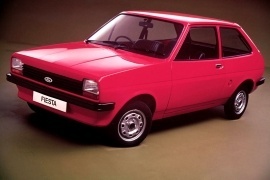The Fiesta project started in 1972 when Henry Ford II approved a small-sized, front-wheel-drive vehicle built as a world car to be sold globally.
Ford’s engineers noticed the ascending trend of front-wheel-drive vehicles on the market. Moreover, the carmaker already produced the Taunus in Europe since 1960 with that architecture, and it was very successful for small cars. But the Fiesta was smaller and perfect for receiving that engine-transmission configuration.
The blue-oval brand tried to build the Fiesta as an affordable vehicle, but without being bland. Its small, rectangular headlights with separated turn signals underneath them were a new trend for the carmaker. A black plastic grille with horizontal slats was spread between them, above the metallic bumper. Behind it, a longer apron continued the front fascia. From its sides, the slightly arched ascending beltline formed a specific design cue for the little vehicle. In the back, the Fiesta featured a wide-open tailgate between the narrow, vertically mounted taillights.
Inside, it was just as simple as on the outside, with a flat dashboard that sported an open storage area in front of the passenger. The instrument cluster featured two round dials for the speedometer and tachometer and a smaller one for the fuel level. It’s flat front seats were good as a daily commuter, but nothing special. In the back, surprisingly, the car offered room enough for two adults.
Under the hood, Ford installed a choice of four engines ranging between 45 hp and 83 hp. The XR2 version used the latter.

























































